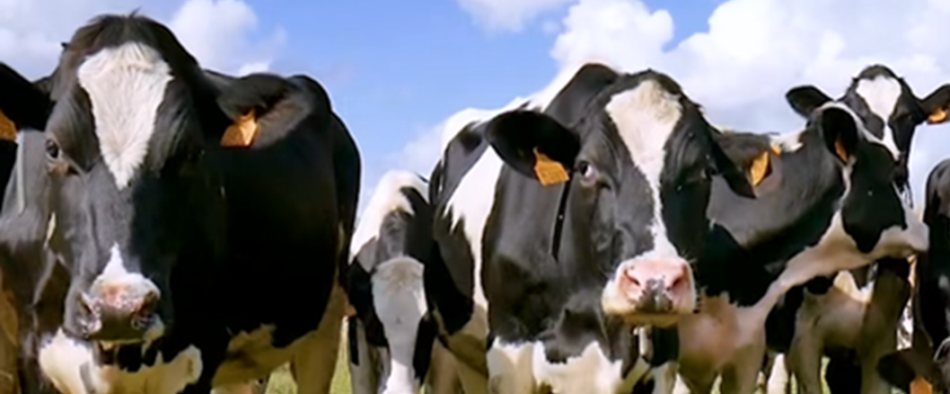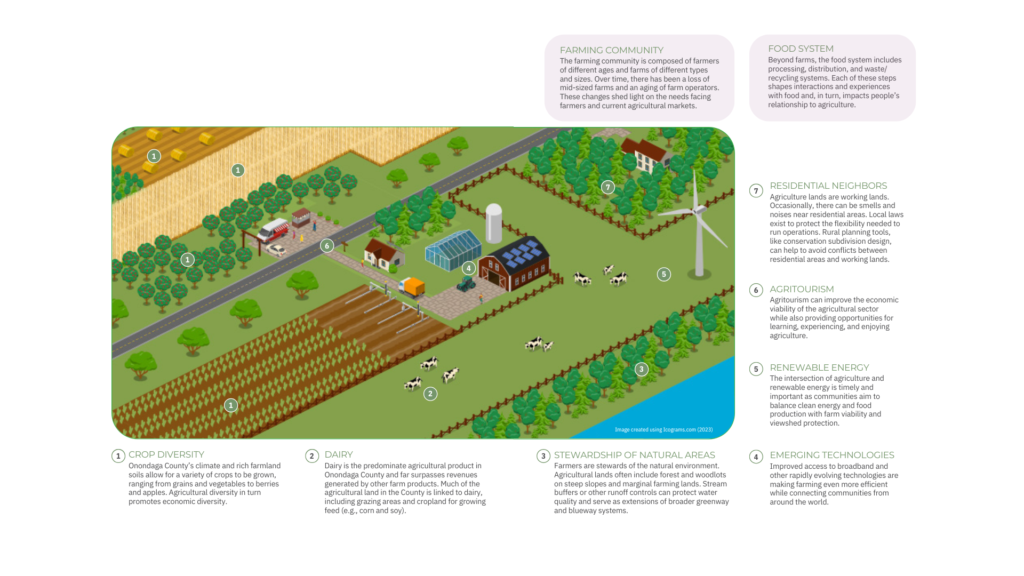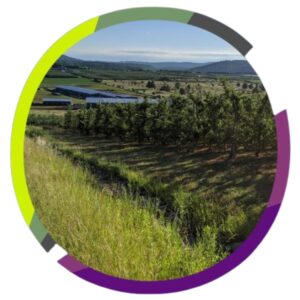Agriculture is the science, art, and business of cultivating soil, producing crops, and raising livestock. Innovative agricultural and farming practices are needed to promote economic development while also protecting our environment.
Vision
Onondaga County will ensure that Agriculture remains a viable and integral part of the economy and a defining characteristic of the landscape.
Agriculture is integral to Onondaga County’s economy, food system, and landscape. The 623 farms in the County provide $356 million in annual direct and indirect food sales.
Agriculture In Onondaga County
Approximately 1/3 of Onondaga County is in agricultural production. Farmland is primarily concentrated in the western and southern portions of the County, although there is a diverse array occurring in the northern and eastern areas as well. Urban farms, community gardens, and edible forests have emerged in urban areas, too.
Farms in Onondaga County are among the most productive in the State and are well-connected to local, national, and international markets. The top selling agricultural products are dairy, grains and legumes and poultry and eggs. Onondaga County ranks third in egg/poultry production and ninth in dairy production in the State.
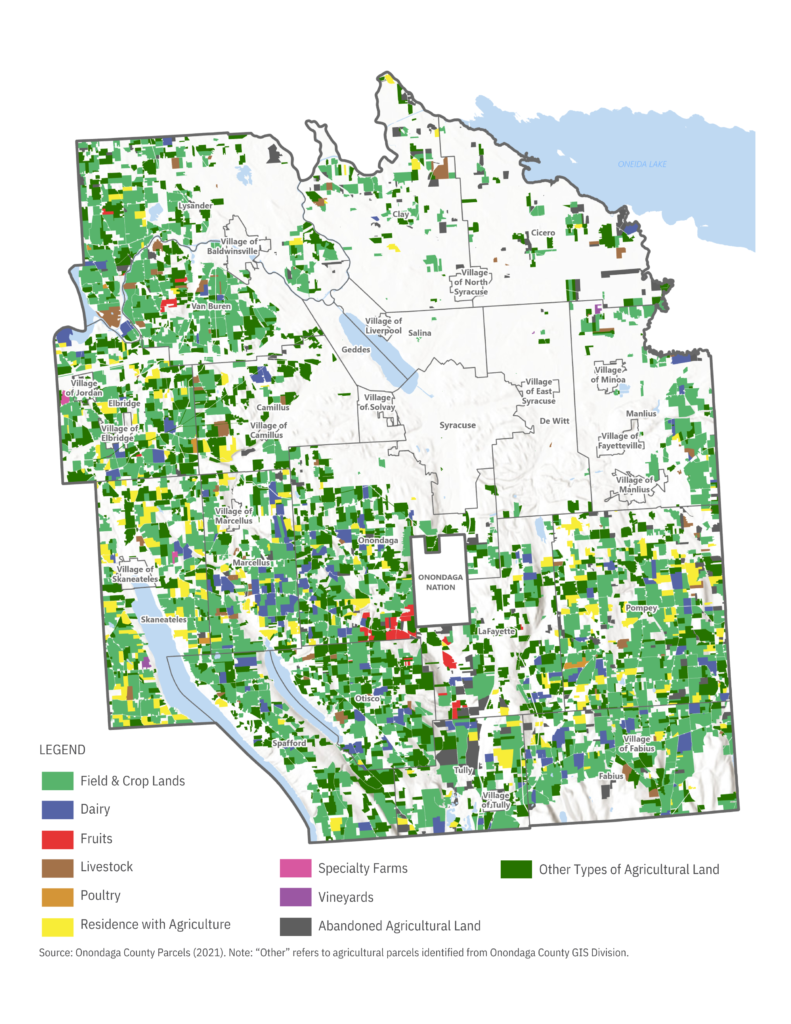
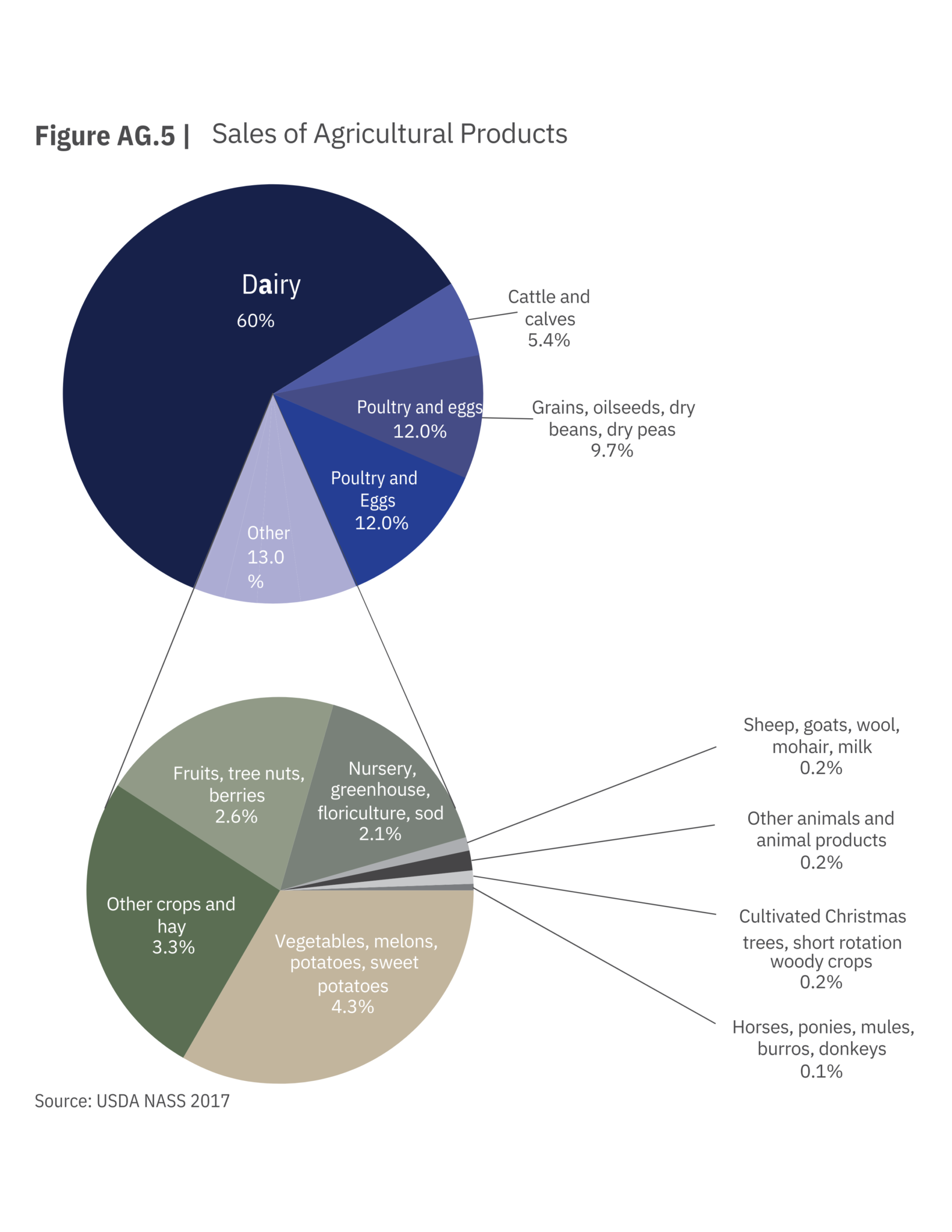
Soils are the Foundation
Nearly 70% of the County’s total land area has been classified as Prime Farmland and Farmland of Statewide Importance. These prized agricultural soils in Onondaga County are plentiful but are relatively rare globally. The temperate climate of Central New York and freshwater availability make local soils particularly good for a variety of food crops and agriculture uses.
One inch of rich topsoil can take several hundred years or more to development. Furthermore, soils are living complex ecosystems of nutrients and microbes. When rich soils are eroded or developed upon, it is very difficult to rebuild them back to their original state.
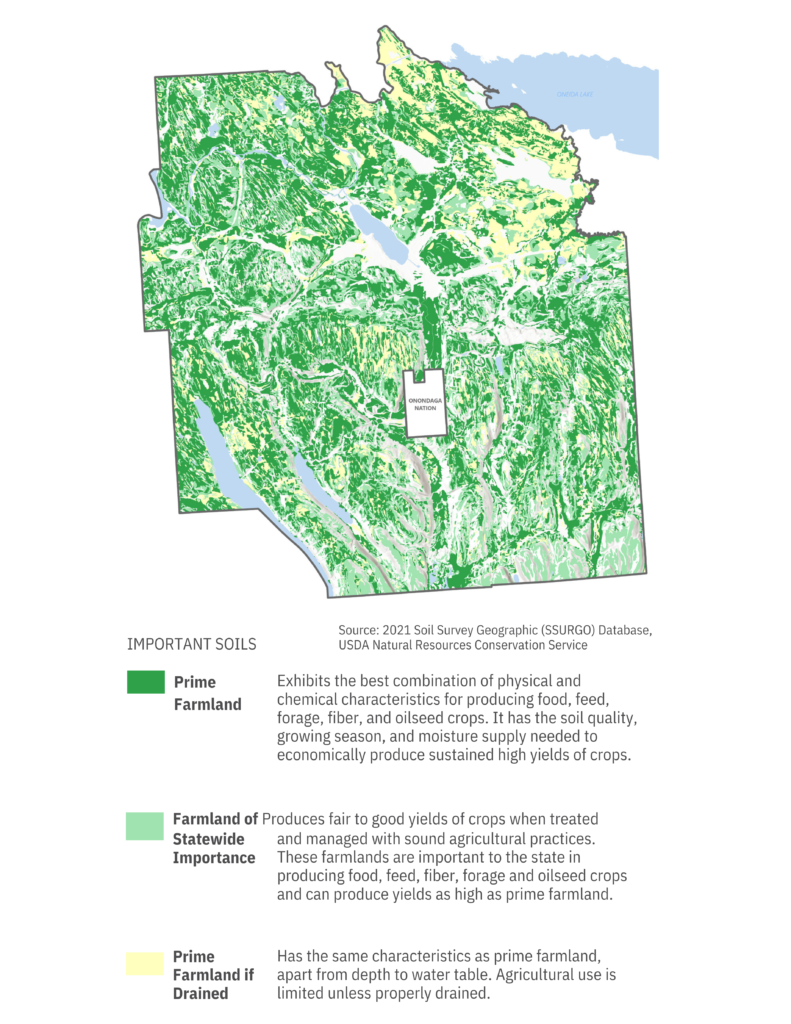
Why Plan For Agriculture?
Economy
The local agricultural industry is dominated by dairy production but also features a wide diversity of operations including vegetables, fruits, tree nuts, and berries, and nursery, greenhouse, and floriculture production.
There is a strong legacy of farming know-how and innovation that supports the local economy, particularly in rural communities. The growth of agritourism has helped to increase and diversify farm incomes, develop connections between local agriculture and communities, and provide tourism opportunities.
Finally, farms pay more in tax than it requires in government services. It makes good local financial sense.
Growing the agriculture economy is an important goal within the regional economy.
Food Systems
Located at the crossroads of Upstate New York, local access to labor, markets, and distribution infrastructure is robust. The Central New York Regional Market (link), local farmers markets, and area farmstands (link to Onondaga Grown!) provide local food access to many areas of the County.
Localizing food systems and expanding food access can increase farm revenues, enhance food security, provide better access to healthy foods, and improve public health outcomes.
Landscape
Local farms are a fundamental element of our local culture and visiting them during the growing and holiday seasons is deeply entwined with a Central New York lifestyle.
There is an intrinsic connection between agriculture and natural resources, and a recognition that farmers are the stewards of our lakes and streams, wetlands, soils, forested lands, ecological corridors, and scenic open spaces.
Protecting and supporting local farms helps to protect our sense of place and valuable natural resources.
Components of Agriculture
Understanding the different components that make up Onondaga County’s agricultural system is an important first step toward County-wide recommendations and investments. The diagram below depicts the complexity of farms which undergo constant pressure to find and keep land in production, transport crops to market, and keep operations viable.
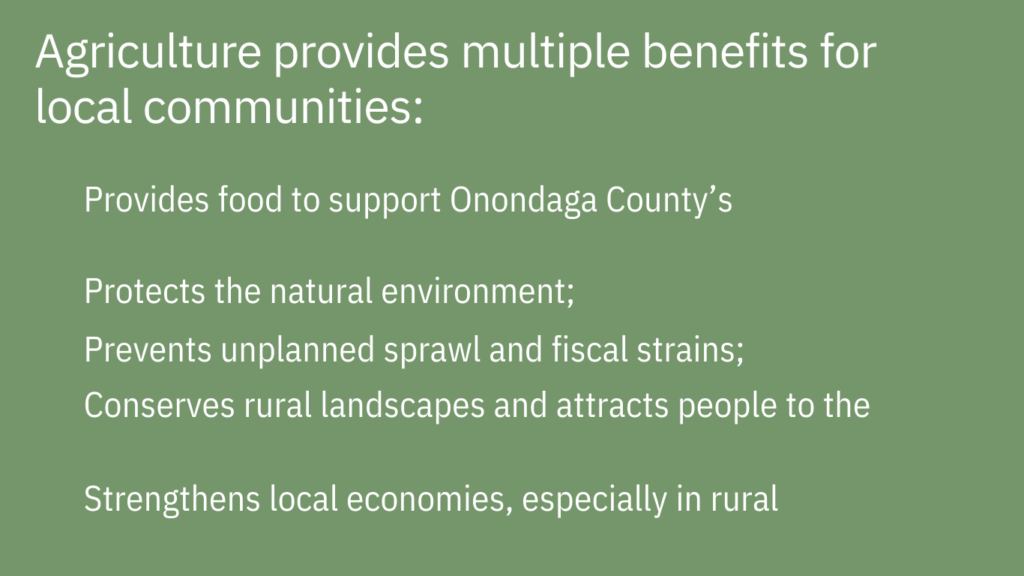
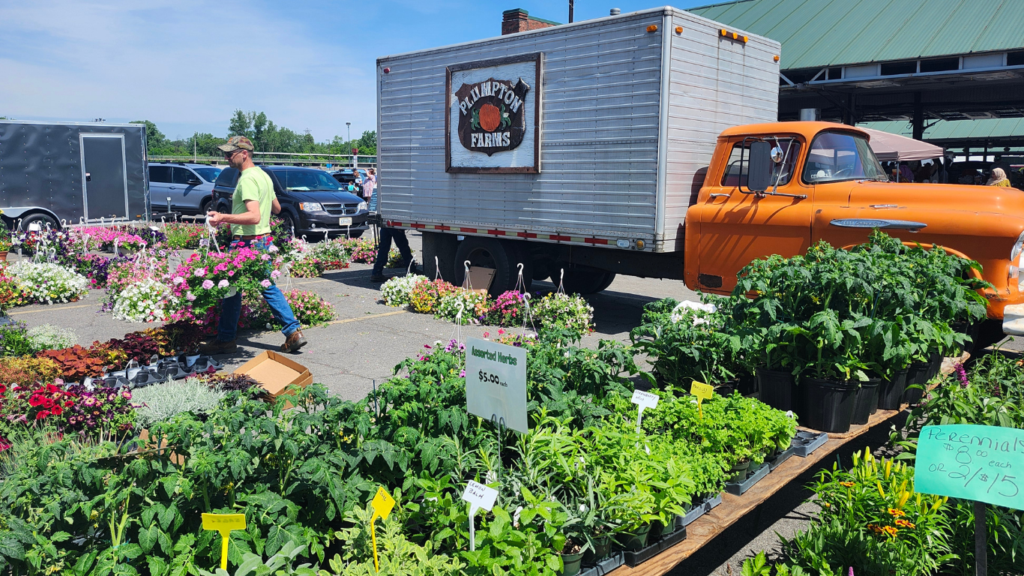
Goals and Strategies
Agriculture is a critical component of the economy, landscape, and food system of Onondaga County. There are multiple factors that can contribute to the future growth and sustainability of agriculture in the County. These goals are intended to further the purpose for planning for agriculture as a primary land use to continue to provide food, support the local economy, prevent unplanned development, and protect natural resources.
Strategy 1:
Continue to support the work of the Onondaga County Agricultural Council and other “Buy Local” programming.
Strategy 2:
Promote and evaluate opportunities for local farmers’ markets and other ways to deliver fresh local farm products to residents especially in urban and suburban areas.
Strategy 3:
Support and encourage local famers’ markets in Onondaga County communities.
Strategy 1:
Foster agricultural economic development opportunities such as agritourism and food processing ventures.
Strategy 2:
Create an Agritourism Economic Development Plan.
Strategy 3:
Support new farmers and the next generation of farmers.
Strategy 4:
Continue to support implementation of new technologies that benefit agriculture, such as Onondaga County’s $15 million broadband program.
Strategy 1:
Continue to support agricultural conservation easement programs by finding ways to increase capacity at local land trusts, and implementing the Agricultural and Farmland Protection Plan.
Strategy 2:
Work with local communities to facilitate planning and policies that prevent the fragmentation and marginalization of farmland.
Strategy 3:
Create and promote decision-making aids like farm friendly land use information and the Onondaga County Ag Mapper when making land use decisions.
Strategy 4:
Utilize the Onondaga County Agriculture and Farmland Protection Board and Agricultural Council programs to support County and local efforts to promote local farms, furthering agricultural economic development efforts, and staying connected to farms, and the public.
Strategy 5:
Evaluate local land use policies against this and other plans when considering investments in new infrastructure and incentives to private development to prevent the conversion of farmland.
Strategy 6:
Promote the adoption of agricultural conservation subdivision regulations in agricultural areas and promote infill development in villages and hamlets where infrastructure is in place.
Strategy 7:
Develop and promote policies to facilitate the balancing of the need to protect viable farmland with the interest to develop renewable energy projects.
Strategy 8:
Develop and promote land use best practices that support agriculture and maintain it as a primary land use in Onondaga County.
Strategy 1:
Continue to support agencies like the Onondaga County Soil and Water Conservation District in assisting farms to implement Best Management Practices that benefit both the farm and the natural environment through outreach and education.
Strategy 2:
Utilize and promote incentive programs for farmers to protect buffers along waterways, wetlands, and other sensitive areas.
Strategy 3:
Recognize and plan for protection of scenic views of and within rural areas.
Onondaga County Agricultural Programs
Explore our Interactive Mapper
In this map, you can enter an address, pan around with your mouse, or zoom in to a municipality, neighborhood or individual parcel t view the agriculture and farmland protection data presented in the storymap. In the top right corner, click on the Legend button to see the list of current data layers. To add or remove layers from view, click on the Layer List button (some layers require you to zoom in). Click on the Basemap Gallery icon (4 boxes, below the address field) to change your background type.
Trends in Agriculture
There are a variety of shared factors influencing the viability of agriculture across the United States and in Onondaga County.
Loss of Farmland
This conversion threatens the future of agriculture, particularly near urbanized areas like Syracuse. New York State has a high conversion threat compared to other states, and a moderately robust set of policy measures and incentive programs to preserve farmland.
Onondaga county has lost nearly 150,000 acres of farmland since the 1950s due to development, however, that loss has plateaued in recent years.
The biggest threat to agriculture as a land use are unplanned, wasteful development, competition for land, and conflicting land uses. The loss of farmland jeopardizes the intricate local farm economy and reduces resources available for new and small farmers.
Aging within the Farming Community
In Onondaga County the average age of farmers has increased as the number of younger farmers has decreased. The loss of skilled and experienced farmers presents many challenges for the viability of agriculture in Onondaga County.
Consolidation of Farms
There are many impacts resulting from farm consolidation. Large farms, which are more efficient and create economies of scale, can pay more for land, affecting competition and limiting supply within an area. Counties with increasing consolidation typically decline in the number of new farmers, while the average age of farm operators increases.
While new farms are emerging in Onondaga County, mid-size farms are in decline and are being absorbed by larger operations or sold for urban development. These dynamics are related to a decline in farm operations overall and a more limited diversity of agricultural products, with a larger segment of agriculture now focused on the challenging and land intensive dairy industry.
Growth in Agritourism
Agritourism also provides farmers with an important source of supplemental and diversified income. And it can also contribute additional revenues for rural farm communities.
Agritourism has become a significant contributor to the local economy in Onondaga County, which is home to nationally renowned Agritourism establishments. Onondaga County farms that participate in agritourism generate more than twice the average revenue of a typical agritourism operation in New York State.
Renewable Energy
Developers often select agricultural land due to relatively flat topography, minimal need for clearing, and proximity to roads and electrical infrastructure.
Renewable energy projects can provide needed supplemental diversified income for farmers and landowners, and numerous co-benefits for local communities. But there is concern that they can disrupt the local availability of farmland for production and negatively impact local viewsheds and rural character.
As of 2022, infrastructure to produce 64 megawatts of solar energy was installed on approximately 385 acres of land in Onondaga County. And the amount of solar capacity more than doubled in 2022 compared to previous years.

